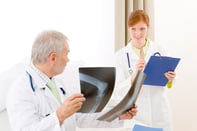Published on
MOOCing the Mini Med

Why did we decide to end an outreach program that was wildly popular for 24 years?
The University of Colorado Mini Med School, a free live lecture series, was delivered annually to the public. The talks explained the basic science underlying medicine in language that the layperson could understand. Its audience, though, was limited to those who could get to class on campus or to a few remote sites.
Then MOOCs happened. We saw the delivery model as an opportunity to reach more people and, at the same time, completely reimagine the Mini Med School.
How do you transition an in-person program to one that’s completely online? We kept our core values intact: no specific prerequisites, requiring explanations that are neither cloaked in technical terminology nor dumbed down; high quality of presentation and content; up-to-date and important topics; and active engagement between student and teacher.
The scope of this project was larger than anything we had attempted. Reality indicated this would be a serious investment of time, rather than money. We estimated the transition could be accomplished in 7 months. It actually took us 18. JJ, founder of the Mini Med School and the content expert, worked almost full time. Helen, designer, illustrator, technologist and flunky, added evenings and weekends.
The learner time commitment in the live program was 7 weekly hour-long lectures followed by about 30 minutes of Q&A. To match that we would prepare between 7 and 9 weekly single-topic video units averaging 6:30 minutes each, and run a discussion forum enlivened by some of our enrolled, full-time (“real”) medical students. Then we began to face the challenges the new format raised.
It’s a rule that anything you put on the Web can eventually go public, so the fair-use doctrine of the classroom must yield to the use of licensed images. This took a significant time investment, creative searching and skillful begging. We obtained the majority of the images under Creative Commons licenses. We purchased a few, and created the rest.
The exciting prospect of international learners meant we would take an international approach. We avoided slang and terms that are unique to the States. JJ, who narrates the units, was particularly careful to enunciate clearly both for those who are learning new terminology and those who know English as a second language. The default units are metric, money is mostly in Euros, and statistics are for the world rather than the USA, when available.
One of the founding principles of the Mini Med School is respect for the intelligence of the attendees. The learners are as smart as the teacher; they just have different vocabularies. The narration scripts were adjusted to a grade-10 reading level (considerably higher than the science content of most media). Videos could be short (mean duration 6:20) because they were meant to be watched in sequence. Concepts could be built on prior learning.
One of the favorite aspects of the in-person course was the access to the science teachers. We didn’t want to lose that personal connection but found talking-head videos dull. Online, visuals have to carry the explanation and engage the viewer. We used brief videos to introduce the course makers, and then almost all the content consisted of narrated imagery.
For a variety of reasons, we chose Camtasia in conjunction with PowerPoint as our video production solution. This meant using PowerPoint as an animation tool and turning our instructor into an advanced PowerPoint expert. He learned from online tutorials and lots of trial and error. The resulting videos show complex concepts with clarity and a certain playfulness that participants found relieved sometimes grave topics.
The course ran in fall 2014, and launched for its second run on 8 June 2015. Was all the time invested worth it? Absolutely. Here are some things we discovered.
The audience represented 150 countries, in addition to all 50 states in the USA. Many more participants were able to be actively involved with the discussion online than could ever ask questions in the live program. This changed the dynamic from student/teacher interactions to group conversations, with experts there to reinforce or redirect to resources only when necessary. We were delighted that even though the attendees were diverse in background, age and culture, everyone was supportive of expanding the knowledge of the group. Not a single troll posted.
Scripted videos are far more efficient than ad-libbed lectures. In the same amount of time, we covered about twice the content per week than we had been doing in the live series. Though the videos were information-dense, they could be paused by the viewer. Also, complete transcripts were available of every unit. All of this made the Mini Medical School more substantial than we’d imagined, and the time spent per student was over twice our estimate. Additionally, we discovered that most people visited the optional materials that we provided relating to each video.
From surveys and discussion forum comments we learned that Mini Medical School:
- Helped high school and college students make career decisions.
- Helped participants understand their own health problems, and those of friends and family.
- Expanded the understanding of medicine for people working in health-related fields.
- Allowed lifelong learners to enjoy refreshing old knowledge and in addition to new learning.
- Guided learners towards behaviors that could lessen risk of cancer, metabolic syndrome, cardiovascular disease, and, through vaccination, common infectious diseases.
Because the units were designed to be up-to-date and clear to a beginner, one unanticipated consequence is that they have been valuable to the students in our campus programs, including first-year medical students. The expertise we gained in how to make these units will be applied to further subjects for a growing number of educational uses.
Author Perspective: Administrator



